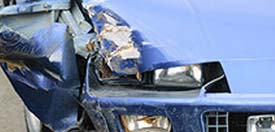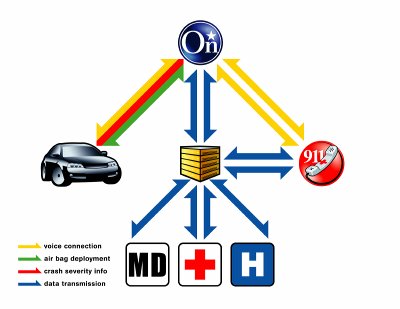|
 When
a vehicle crash occurs, a quick medical response often can mean
the difference between life and death. In an effort to help
911 centers dispatch the appropriate life-saving staff and equipment
to crash scenes faster, General Motors will begin adding an
advanced automatic crash notification (AACN) system to vehicles
equipped with OnStar, the first automaker to do so. When
a vehicle crash occurs, a quick medical response often can mean
the difference between life and death. In an effort to help
911 centers dispatch the appropriate life-saving staff and equipment
to crash scenes faster, General Motors will begin adding an
advanced automatic crash notification (AACN) system to vehicles
equipped with OnStar, the first automaker to do so.
Currently,
OnStar, an embedded in-vehicle safety and security communications
system, is automatically notified within seconds when a subscriber’s
air bag deploys. The next-generation GM automatic crash notification
system linked with OnStar will assist even more customers by
taking this potentially life-saving service beyond air bag deployments.
Using a collection of strategically located sensors, the GM
AACN system will automatically call for help if the vehicle
is involved in a moderate to severe frontal, rear or side-impact
crash, regardless of air bag deployment. Also, the new system
provides crash severity information to OnStar call center advisors,
who relay it to 911 dispatchers, helping them to quickly determine
the appropriate combination of emergency personnel, equipment
and medical facilities needed.
“With
the new technology of this enhanced GM crash notification system,
we have a tremendous opportunity to save more lives,” said
Robert C. Lange, GM executive director of vehicle safety. “AACN
will assist emergency personnel in determining crash severity
in those precious minutes following a crash, and help get the
right people to the scene faster.”
Dr.
Rick Hunt, M.D., is president of the National Association of
EMS Physicians and professor and chair of emergency medicine
at SUNY Upstate Medical University in Syracuse, N.Y. He recalls
instructing EMS workers in the 1980s to take instant photos
of crashed vehicles so that he could correlate possible patient
injuries with the damage to the vehicle. “Until then, patients
would be brought to the emergency department and we had no information
on the crash at all. For $2 worth of film we got a huge amount
of data.
”The
wonder of AACN technology is that it will give us more crash
information than ever before – a high-tech crash ‘photo’
– which helps us take better care of our patients. The
National Association of EMS Physicians and I look forward to
working with GM and OnStar as they lead in the introduction
of this technology in the auto industry.”
The
AACN system works by using new and existing sensors in conjunction
with advanced intelligence to transmit key crash data including
the direction of impact and the impact force. Impact force is
one of the most important pieces of data used to determine the
severity of a crash.
When
the AACN system is triggered by a crash of sufficient severity,
an emergency voice/data connection will be established with
an OnStar call center. The advisor will use the voice channel
in the vehicle to communicate with the crash victims and, at
the same time, conference-in the nearest public service answering
point (911 dispatcher) and provide specific data about the severity
of the crash. The 911 dispatcher can then inform emergency responders
of the data. In the future, AACN data may be transmitted electronically
to the 911 centers, emergency responders, emergency departments
and trauma centers using secured internet connections.

Eventually,
the system may be capable of determining how many occupants
are in the vehicle, whether they are using safety belts and
other information that helps emergency responders further anticipate
the types and severity of injuries that may have occurred in
a crash.
The
GM AACN system will be available beginning in 2003 on about
400,000 OnStar-equipped 2004 model year vehicles, including
the Chevrolet Malibu, Chevrolet TrailBlazer, GMC Envoy and Envoy
XUV, Oldsmobile Bravada and the Buick Rainier. AACN will be
added to additional GM model lines equipped with OnStar in subsequent
model years.
The
system will be rolled out into vehicles sold in the U.S. and
Canada. |